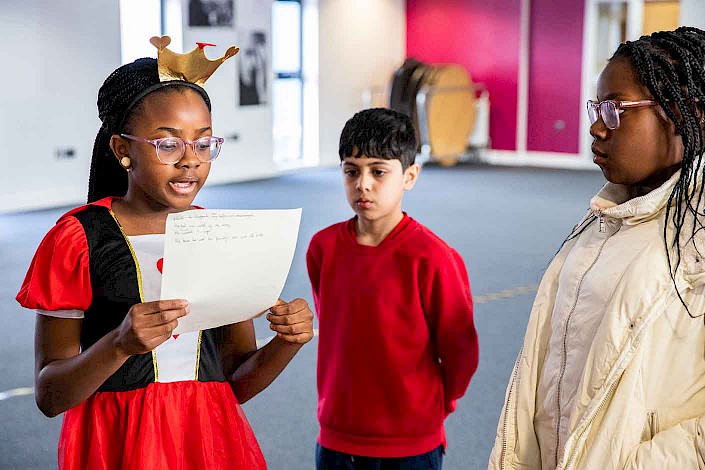Bringing Your Stories to Life Through Words and Music
For thousands of years stories have been shared through music and lyrics which can be passed on through the generations.
Composer Aga Serugo-Lugo and Librettist Hazel Gould give some top tips, advice and activities to get started

A pupil practices reading her composition aloud
Storytelling through words
When we’re writing song lyrics connected to a story, the first thing is to decide what job you want your song to do. Do you want the song to be an introduction: something that sets up characters, place and time? Maybe the song will reveal something new about a character, like how they really feel, or share a secret they are hiding from the world? Or perhaps your song needs to move the story forward - for example, if you were writing songs for the story Cinderella, you could have a song which shows lots of people trying on the glass slipper with no luck, but then sing about the moment Cinderella tries it on and it fits!
Once you have made that decision, you need to know what point of view the song should have. Are you looking at a situation from above and describing it? Or are you inside a character and singing from their perspective? This decision will change the way you write, not only simple technical things like which pronouns you will use (they/them or I/me/we/us), but also the way you write about a situation. To use Cinderella as an example again, If you wanted to write a song about her miserable life at the beginning of the story, are writing from her point of view (in the first person) you might choose to give her blunt sad lines like “I am so miserable, nothing will every change, my life is so dull” , but when you are writing from a more distanced perspective (in the third person) you have the opportunity to give some information that the characters won’t have so in describing Cinderella’s miserable life, you could use your song to be hopeful, or look into the future for example “she thinks she has no hope, but she has no idea what magic her future holds”.
Song lyrics can be very short. Try to really pinpoint what you want to say, and say it clearly.
Finally, think about how you want your audience to feel. Do you want to make them dance? Make them angry? Encourage them to have sympathy for a character or situation. This will inform your word choices, and ultimately your musical choices.
You don’t need to rhyme, and you can dictate your own structure - ie. if you want verses and a chorus, or whether you want a more free and flowing text.
Song lyrics can be very short. Try to really pinpoint what you want to say, and say it clearly. Have fun with your lyrics, but generally speaking songs which are overloaded with words are more difficult to sing, perform and hear (there are definitely examples of songs with loads of words which are absolutely brilliant though - so this is not a hard and fast rule).
Storytelling through music
For many people, the hardest thing in any creative activity is the starting point.
Once you have some words, how do you add a tune (melody)? Have no fear, here are some simple tips for creating a tune.
For this we will use the phrase: “The snow is falling, it makes me smile”
1. Improvise
The best and easiest way to come up with a melody is to just try and make one up: improvising. Say the phrase over and over again.
“The snow is falling, it makes me smile”
You’ll find that it has a natural rhythm from how you say it. This time try and add pitch to it, (sing it). If you like it what you’ve done, keep it. If you don’t, try it again.
2. Respond to a doodle
Another method is to doodle method. This is where you just draw a squiggly line and let your voice follow the shape.

In this example the tune goes down for “The snow is falling” and goes up and down for “it makes me smile”. If you like it, keep it. If not, try and sing it again, but with the same shape. If you still don’t like it, draw another doodle, and see what it reveals.
3. Word painting
Here we look at the meanings of the text and draw simple doodles that reflect what you think is happening.


Now try and create a melody that responds to the shapes you created. This should give your melody a nice shape. Remember you can hold notes, repeat words and have more than one note on any syllable (so the word smile in his example could fall and rise all on its own).
4. Play with the rhythm
All these examples have used the natural rhythm of the phrase (as though you were speaking). Here is the natural emphasis.
The snow is falling, it makes me smile
But one of the fun aspects of songwriting is that you can force a rhythm onto a phrase to make it feel completely different.
The snow is falling, it makes me smile
This version feels snappier and rockier than the first.
Repeating words and adding rests also changes the rhythm.
The snow, snow, snow is falling [Rest] it makes me smile.
Try all these methods and see what tunes pop up.
Aga’s Top Tips
- Choose a theme and create a mind map with words around your theme
- Think about the 5 senses: sound, sight, taste, touch, smell
- Think specifically about adjectives (describing words)
- Think specifically about verbs (doing words)
- Physicalise the concept (create 3 physical gestures in response to an idea)
- Personify (turn into a person) your topic (e.g. ‘Air the Ballet Dancer)
- Try and storyboard parts of your idea
- Ask yourself: Who? What? Where? When? And Why?
Hazel’s Top Tips
- Speak the words aloud, find out how they feel. This will give you a really good idea about how well they can be set to music
- Be flexible. When the music writing process starts, the lyrics often change. I find this an exciting process, but it can be frustrating. It’s important to be open to change so that the music and the words can come together to form the best song you can make
Sharing Our Lives: Thurrock Songs
Three songs were created as part of the Thurrock Sharing Our Lives project, all of which are available for anyone to download, sing and perform. The songs are accompanied by music scores, lyric sheets, learning and backing tracks. We’d love to know if you end up performing any of these songs.
Bursting With Joy was co-written with students from the Gateway Learning Community in Tilbury, along with composer Aga Serugo-Lugo and rapper and lyricist Capo Lee, inspired by the journeys of two members of the school community – a parent who had travelled to the UK from Ghana, and a teacher who had moved from Nigeria to Thurrock. The stories were interwoven to create an uplifting song of resilience and hope overcoming adversity.
You can hear the song here, and find the music score, lyrics, practice and backing tracks here.
The making of ‘Bursting With Joy’ – a short film
Welcome to the Estuary was co-written with members of Thames Opera Company, along with composer Aga Serugo-Lugo, librettist Hazel Gould and musician Gurdain Rayatt. It was inspired by memories and experiences shared by members of the Gurdwara community in Grays, and captures the excitement and challenges faced when building a life in a new country, as well as exploring what it means for settled communities to welcome people who are newly arrived in a local area.
You can find the music score, lyrics and Punjabi learning guide here.
The Look was co-written by members of the combined Thurrock Gospel Choirs, run by Thurrock Music Services along with composer Aga Serugo-Lugo and librettist Hazel Gould. It explores the experience of moving to a new place, the meeting of cultures, and finding belonging.
You can hear the song here and find the music score, lyrics, practice and backing tracks here.